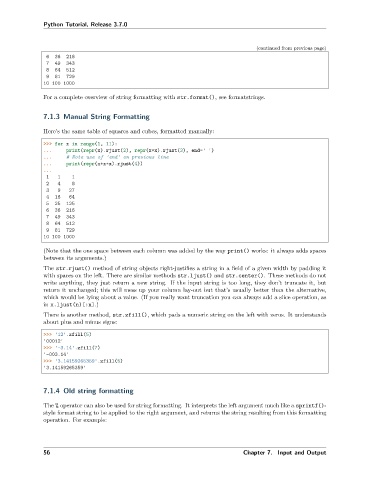Page 62 - Python Tutorial
P. 62
Python Tutorial, Release 3.7.0
(continued from previous page)
6 36 216
7 49 343
8 64 512
9 81 729
10 100 1000
For a complete overview of string formatting with str.format(), see formatstrings.
7.1.3 Manual String Formatting
Here’s the same table of squares and cubes, formatted manually:
>>> for x in range(1, 11):
... print(repr(x).rjust(2), repr(x*x).rjust(3), end=' ')
... # Note use of 'end' on previous line
... print(repr(x*x*x).rjust(4))
...
11 1
24 8
3 9 27
4 16 64
5 25 125
6 36 216
7 49 343
8 64 512
9 81 729
10 100 1000
(Note that the one space between each column was added by the way print() works: it always adds spaces
between its arguments.)
The str.rjust() method of string objects right-justifies a string in a field of a given width by padding it
with spaces on the left. There are similar methods str.ljust() and str.center(). These methods do not
write anything, they just return a new string. If the input string is too long, they don’t truncate it, but
return it unchanged; this will mess up your column lay-out but that’s usually better than the alternative,
which would be lying about a value. (If you really want truncation you can always add a slice operation, as
in x.ljust(n)[:n].)
There is another method, str.zfill(), which pads a numeric string on the left with zeros. It understands
about plus and minus signs:
>>> '12'.zfill(5)
'00012'
>>> '-3.14'.zfill(7)
'-003.14'
>>> '3.14159265359'.zfill(5)
'3.14159265359'
7.1.4 Old string formatting
The % operator can also be used for string formatting. It interprets the left argument much like a sprintf()-
style format string to be applied to the right argument, and returns the string resulting from this formatting
operation. For example:
56 Chapter 7. Input and Output

